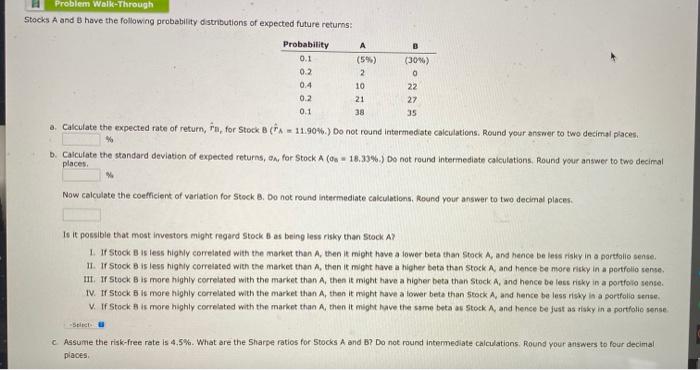Stocks A and 8 have the following probability distributions of expected future returns: a. Calculate the expected rate of return, rBf for 5 tock B(rA=11.90%.) Do not round intermediate calculations. Round your answer to two decimal places. b. Caiculate the standard deviation of expected returns, on, for Stock A ( s=18.33%.) Do not round intermediate calculations. Round your answer to two decimal places. Now calculate the coefficient of variation for Stock B. Do not round intermediate calculations, Round your answer to two decimal places. It It possible that most investors might regard stock 6 as being less risky than Stock A? 1. If Stock 8 is less highly correlated with the market then A, then it might have a fower beta than Stock A, and hence be leis rishy in a porthalio sense. 11. If Stock 8 is iess highly correiated with the market than A, then it might have a higher beta than Stock A and hence be more ritky in a portfolio sense. II. If Stock B is more highly correlated with the market than A, then it might have a higher beta than Stock A,and hence be fess risky in a portfoio sense. V. If 5 tock A is more highly correlated with the market than A, then it might have the smme beta as 5 tock A, and hence be just as riaky in a portfolio sense c. Assume the risk-free rate is 4.5%. What are the 5 harpe ratios for 5 tocks A and 6 ? Do not round intermediate calculations. Rouns your answers to four decimal 1. If Stock B is less highly correlated with the market than A, then it might have a lower beta than S tock A, and hence be less risky in a portiolio sense. II. If 5 tock B is less highly correlated with the market than A, then it might have a higher beta than Stock, and hence be more risky in a portfolio sense. Itt. If Stack B is more highly correlated with the market than A, then it might have a higher beta than Stock A, and hence be iess risky in a porticio serse. IV. If 5 tock B is more highly correlated with the market than A, then it might have a lower beta then 5 tock A, and hence te fess risky in a portfolio sense. V. If Stock B is more highly correlated with the market than A, then it might have the same beta as Stock A, and hence be just as risky in a portfolio sense. c. Assume the risk-free rate is 4.5%, What are the Sharpe ratios for Stocks A and a? Do not round intermediate caiculaticns. Round your answers to four decmal places. Stock A: Stock B: Are these calculations consistent with the information obtained from the coefficient of variation calculations in Part b? 1. In a stand-alone risk sense A is less risky than B. It Stock B is more highly correlated with the market than A, then it might have the same beta as Stock A and hence be just as risky in a portiolio sense. II. In a stand-alone risk sense A is less risky than B. If Stock B is less highly correlated with the market than A, then it might have a fower beta than stock A, and hence be less risky in a portfolio sense. III. In a stand-alone risk sense A is less risky than B. If Stock B is less highly correlated with the market than A, then it might have a higher beta than Stock. A, and hence be more risky in a portfolio sense. IV. In a stand-alone risk sense A is more risky than B. If Stock B is less highly corretated with the market than A, then it might have a iower beta than Stock A, and hence be less risky in a portfolio sense. V. In a stand-aione risk sense A is more risky than B. If Stock B is less highly correlated with the market than A, then it might have a higher beta than Stock A, and hence be more risky in a portfolio sense








